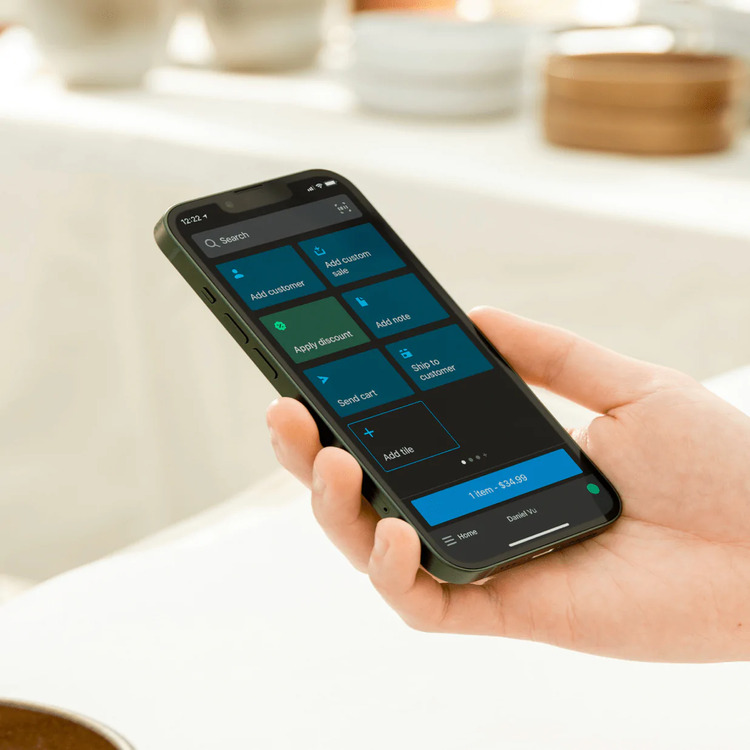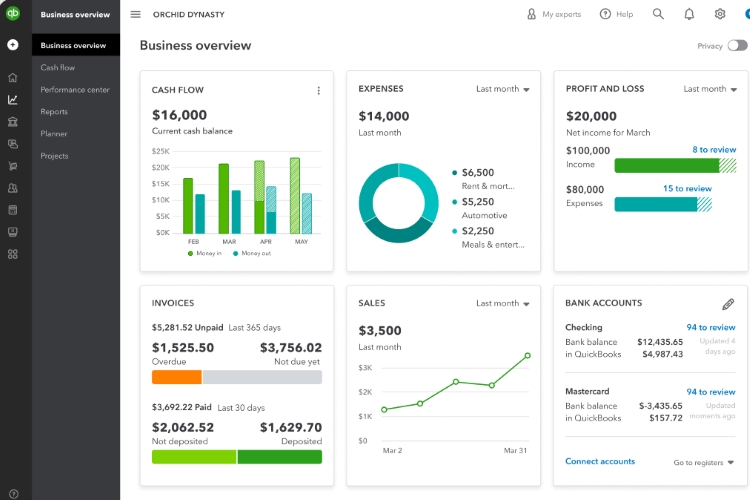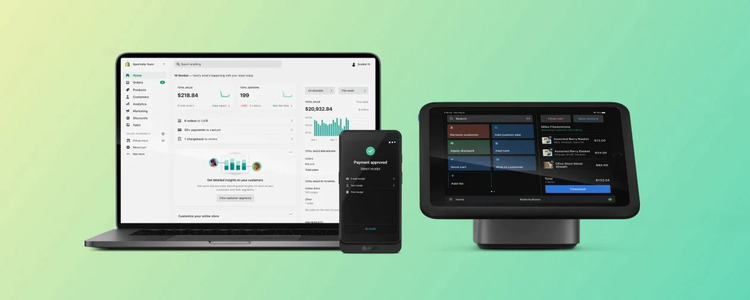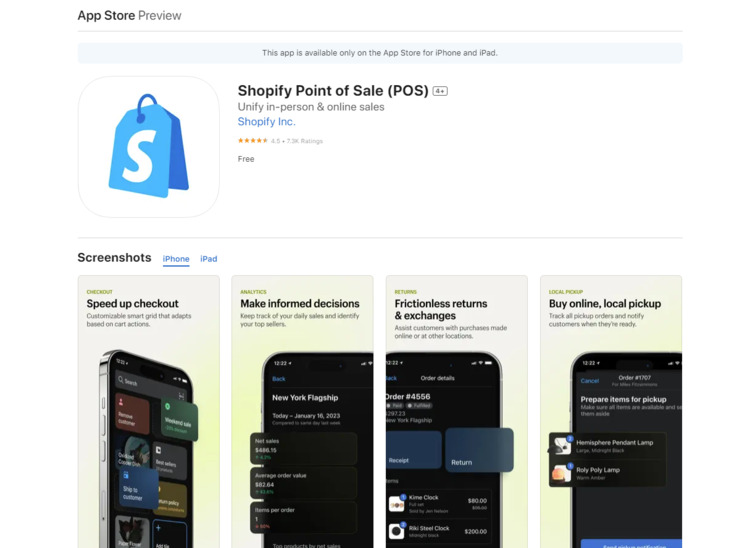QuickBooks POS vs Shopify POS: Why is Shopify POS Better?
QuickBooks POS vs Shopify POS: Understanding the Purpose of the Article
Unlike many other comparison articles available on Google, which solely focus on comparing QuickBooks POS and Shopify POS, our article takes a broader perspective.
We not only conduct an in-depth comparison of the two systems but also delve into the underlying reasons why transitioning to Shopify POS has become an urgent necessity for businesses, especially given the imminent closure of QuickBooks Desktop POS To learn more about the process of migrating from QuickBooks Desktop POS to Shopify POS, you can refer to our previous article titled “QuickBooks Desktop POS to Shopify POS : Our ultimate guide.”
| Key takeaways |
|---|
|
QuickBooks POS vs Shopify POS: The Key Difference
Shopify POS, as a cloud-based solution, can be downloaded and utilized on mobile devices. This portability allows for high versatility; whether you’re at a trade show, pop-up shop, or your brick-and-mortar store, you can carry your POS system with you. Moreover, you can process transactions, update your inventory, and manage customer relationships on the go, directly from your tablet or smartphone.
In contrast, QuickBooks POS is desktop software. You must download and install it on a computer, limiting its mobility. This setup may work well in a traditional store setting with a fixed checkout station, but it doesn’t offer the same flexibility as a mobile solution.
NOTE: QuickBooks POS has two main types of products: QuickBooks POS Desktop (an on-premise system) and QuickBooks Online (a cloud-based system). However, QuickBooks Point Of Sale is shifting to be only a cloud-based system. That’s why QuickBooks Desktop financial software will be discontinued from October 3rd, 2023.
QuickBooks POS vs Shopify POS: Pros and Cons
Here are some pros and cons of QuickBooks POS and Shopify POS:
QuickBooks POS:
Pros:
- Customization: The system can be tailored according to the customer’s needs, enhancing its flexibility.
- Inventory and Sales Tracking: It’s a reliable tool for monitoring store activities such as inventory and sales.
- Organization and Efficiency: QuickBooks POS helps keep things organized with features like “quick find” for efficient searching.
Cons:
- Technical issues: The system may encounter occasional technical issues.
- Steeper Learning Curve: It may require a significant learning curve to fully grasp its features and functionalities, which could be a barrier for some merchants.
Shopify POS:
Pros:
- Unified Commerce Shopify POS Pro integrates seamlessly with your Shopify online store, creating a unified platform for selling across all your channels. Whether your customer prefers shopping online, via social media, or in person, their experience remains consistent, helping you build a strong brand identity.
- Enhanced Mobility With a cloud-based solution accessible on any mobile device, you’re no longer tied to a physical checkout station. You can interact with customers anywhere in your store or even sell at pop-ups, markets, or trade shows, thereby reaching a wider audience.
- In-Depth Inventory Management As a merchant, maintaining an accurate inventory count across all your sales channels can be a headache. Shopify POS Pro offers robust inventory management tools, allowing you to track your stock levels in real-time and prevent overselling.
- Personalized Customer Engagement Shopify POS Pro enables you to create detailed customer profiles. With access to customers’ past purchases and preferences, you can personalize their shopping experience, offer tailored product recommendations, and foster long-term loyalty.
- Business Continuity Internet outages shouldn’t disrupt your sales. Shopify POS Pro’s offline mode ensures you can continue making sales and accepting cash payments, even when the internet is down.
- Promotions Made Easy You can easily set up automatic discounts and promotions, encouraging customers to spend more and thus boosting your revenue. The system applies these automatically at checkout, ensuring a seamless customer experience.
- Data-Driven Decision Making With unified reporting, you get valuable insights into your sales trends, customer behavior, and product performance. You can use this data to make informed decisions and strategic adjustments, driving business growth.
- Simpler Operations Shopify POS Pro is more than just a POS system. It integrates with other Shopify services such as Shopify Payments and Shopify Shipping, simplifying your operations by providing an all-in-one solution.
- Stay Updated Effortlessly The system updates automatically, saving you from the hassle of manual updates. You always have the latest features and security patches to ensure smooth business operations.
Cons:
- Limited customization: The platform might not offer as much flexibility as some other platforms due to the lack of access to the backend code or the database.
QuickBooks POS vs Shopify POS: In-depth Comparison
Pricing
Shopify POS pricing
Subscription fees
In order to use Shopify POS, you’ll have to subscribe to one of the following plans:
- Basic Plan: $39/month
- Shopify Plan: $105/month
- Advanced Plan: $399/month
- Shopify Plus: starting from $2000/month
Once you’re on a paid Shopify plan, you can choose either a free or paid Shopify POS.
- Shopify POS Lite: Free (included in all the Shopify plans mentioned)
- Shopify POS Pro: $89/month per location
You will have to pay only $79 if you subscribe to a yearly Shopify POS Pro Plan.
Also, note that this POS plan is free for those who are already on the Shopify Plus plan.
You can experience this platform for 3 days for free before deciding to purchase a Shopify plan.
Also, for new merchants, Shopify is offering a special deal: you only have to pay $1 per month for your first three months.
So, the cost of using Shopify POS is the Shopify subscription fee plus the POS fee.
Transaction fees
Shopify’s transaction fees can depend on several factors, including your chosen plan, the payment method used, and whether the transaction is online or in-person. Here are some key points about Shopify’s transaction fees:
Payment Methods
- Shopify Payment Gateway: If you use Shopify’s own payment gateway, Shopify Payments, you won’t be charged transaction fees.
- Third-Party Payment Gateways: If you choose to use a third-party payment gateway, Shopify will charge a transaction fee on top of any fees charged by your payment gateway.
- For the Basic Shopify plan, the transaction fee is 2%;
- For the Shopify plan, it’s 1%;
- For the Advanced Shopify plan, it’s 0.5%.
- Manual payment methods: You won’t be charged if you use cash, cash on delivery (COD), and bank transfers.
However, credit card rates do apply in all cases. These vary based on your chosen Shopify plan.
- Basic Shopify Plan: online credit card rates are 2.9% + 30¢ per transaction, and in-person credit card rates are 2.7% per transaction.
- Shopify Plan: online credit card rates are 2.6% + 30¢ per transaction, and in-person credit card rates are 2.5% per transaction.
- Advanced Shopify Plan: online credit card rates are 2.4% + 30¢ per transaction, and in-person credit card rates are 2.4% per transaction.
Please note that the credit card rates above apply to US-based sellers. For sellers outside of the US, check below to see how much Shopify costs in your country.
Shopify POS Hardware Costs
Shopify has adopted a more flexible and cost-effective approach to POS hardware. While the cost of Shopify’s hardware depends on your specific needs, it generally falls into a more affordable range.
For instance, a basic Shopify POS hardware kit—which includes a cash drawer, receipt printer, and iPad stand—can cost around $219. A barcode scanner is an additional $149, and a Tap to pay on iPhone is included for free. If you need to add more devices, such as an iPad, the cost would increase accordingly.
QuickBooks POS pricing
Subscription fees
The pricing of QuickBooks POS can vary, depending on the version you choose. They typically offer three versions:
- Simple Start: $9/month
- Essentials: $16.50/month
- Plus: $25.50/month
- Advanced: $60/month
As Intuit is making a significant change in their products, most of the information, especially about QuickBooks Desktop POS pricing from other sites, may be outdated. Our review includes the most up-to-date information about QuickBooks POS.
Also, Intuit announced that they will stop making QuickBooks Desktop POS available for sale from June 2023.
The pricing above applies to US-based businesses. Businesses from other countries will be charged differently.
Transaction fees
QuickBooks charges fees for various payment methods:
- ACH bank transfer: 1% (Max $10)
- Credit card - swiped: 2.4% + 25 ¢
- Credit card - online invoice: 2.9% + 25 ¢
- Credit card - keyed: 3.4% + 25 ¢
QuickBooks POS Hardware costs
QuickBooks POS has been a mainstay in the industry for many years. The hardware cost for QuickBooks POS can vary widely depending on the specific requirements of your business. For instance, the basic hardware bundle—which includes a receipt printer, barcode scanner, cash drawer, and credit card reader—can cost around $900 to $2,000. They are significantly more expensive than Shopify POS’.
Furthermore, it’s essential to consider the ongoing maintenance costs and potential replacement costs for this hardware. Over time, these can add up and contribute to the total cost of ownership.
Pricing: The Verdict
Shopify is the winner in this battle as it costs little to have both a POS system and an online store.
Ease of Use
Shopify POS: Intuitive Design and Modern Features
Shopify POS is widely acclaimed for its modern, intuitive design. The user interface is not only aesthetically pleasing but also easy to navigate, which makes managing your store’s operations straightforward.
Here’s what makes Shopify POS stand out:
- The system is user-friendly and easy to set up, even for individuals with limited technical expertise.
- Its consistent design across stores provides a unified, reliable experience.
- Shopify POS is portable and available on mobile devices, making it ideal for businesses that operate in various locations or attend events like fairs or pop-up shops.
- The system allows for the creation of custom orders and customer profiles, enhancing its usability.

Despite these strengths, it’s worth noting that some merchants found Shopify POS to be more user-friendly than others, suggesting there might be a slight learning curve for some people.
QuickBooks POS: Simplicity and Familiarity
QuickBooks POS stands out with its simple, user-friendly interface. Its seamless integration across devices and platforms is one of its notable features, making sales and report generation a breeze. This system is designed for all types of retail businesses, so it’s versatile enough to meet diverse needs.
Key points to note about QuickBooks POS’s ease of use include:
- The software is regularly updated every other year, with each upgrade bringing new features and improvements, making it easier to use over time.
- Data backup is straightforward, making recovery from a system crash hassle-free.
- The system functions offline, ensuring operations continue smoothly even during internet downtime.
- QuickBooks POS boasts robust reporting capabilities and store custom staff permissions, enhancing its ease of use.

However, QuickBooks POS isn’t without its share of challenges. Some merchants have reported difficulties with certain functions, such as correcting sales, managing inventory, and handling receivables. Additionally, integrating QuickBooks POS with QuickBooks accounting isn’t always a straightforward process.
Ease of Use: The Verdict
Shopify POS, with its modern, intuitive design and portability, is the winner in this battle.
Features and Functionality
Shopify POS: A Comprehensive System
Shopify POS offers a seamless user experience, particularly for those already using a Shopify eCommerce account. With Shopify, you have everything right in one place, making it easy for you to manage and track important data. The features include:
- Payment Options: Shopify POS accepts multiple card and mobile wallet payment options, including Visa, Mastercard, American Express, Discover, Apple Pay, and Google Pay. It even allows for split payments among these options.
- Automatic Discounts: Shopify has introduced an automatic discount application feature, enhancing the checkout process and customer experience.
- Advanced Features with Shopify POS Pro: The Pro edition of Shopify POS offers advanced functions such as smart inventory management, omnichannel selling features, unlimited registers, staff roles and permissions, In-store analytics, and in store pick-ups and returns.

QuickBooks POS: Strength in Inventory Management
QuickBooks POS, much like Shopify POS, offers a user-friendly interface packed with features that improve customer interaction and streamline business operations.
- Custom Reporting: QuickBooks POS offers custom reporting options, particularly with its Pro and Multi-Store editions.
- Inventory Management: QuickBooks POS stands out for its robust inventory management features, including automatic purchase order generation based on preset levels, and work order and sales order tracking.
- Employee Management: QuickBooks POS also offers comprehensive employee management functions, including commission tracking and payroll integration.

Both Shopify POS and QuickBooks POS offer several similar features, including loyalty program integrations, first-party payment hardware, custom staff permissions, and managing multiple store locations. However, there are also features exclusive to Shopify POS Pro, such as unlimited sales, unlimited registers per location, local pickup and delivery, in-store exchanges and returns of online purchases, integrated customer order history (both online and in-store), online and in-store gift card redemption, unlimited SKUs, unlimited sales channels, and 24/7 support.
Shopify POS vs QuickBooks POS: The Verdict
Shopify is the winner because it is more feature-rich.
Software Integration
QuickBooks POS
It’s important to note that as of October 3rd, 2023, QuickBooks Desktop POS will no longer support on-premise installations on Windows and Linux systems. This shift reflects a growing trend toward cloud-based solutions in the industry, but it’s worth considering if your business prefers or requires on-premise installations.
Shopify POS
Shopify POS is also accessible from any device with a web browser. However, Shopify POS has a broader range of mobile compatibility, supporting both Android and iOS devices. This can offer more flexibility to businesses that use various mobile devices.

Shopify POS vs QuickBooks POS: The Verdict
Shopify is the winner because it can be used on more devices.
Hardware Compatibility
QuickBooks POS
QuickBooks POS provides solid integration with standard POS hardware from specific manufacturers, making it a reliable choice for businesses with traditional POS setups. Here are a few things to consider when integrating QuickBooks POS Online with your devices:
- QuickBooks POS Online integrates with many standard POS hardware components: barcode scanners, cash drawers, receipt printers, and credit card readers.
- QuickBooks POS Online is mainly designed to integrate with hardware from specific manufacturers.
- QuickBooks POS Online might encounter compatibility issues with non-standard or less common hardware components.
Shopify POS
Shopify POS stands out with its extensive hardware compatibility and mobile integration, making it a flexible solution for a wide range of businesses. Using Shopify POS, you have to take these things into consideration:
- Shopify POS integrates smoothly with a wide range of POS hardware: barcode scanners, receipt printers, cash drawers, and card readers.
- Shopify POS is compatible with a wider range of hardware manufacturers compared to QuickBooks.
- Shopify POS offers mobile hardware integration, making it suitable for businesses that operate on the go.
- Shopify POS provides the Shopify POS Card Reader, a proprietary device designed for seamless integration and smooth transactions.

Shopify POS vs QuickBooks POS: The Verdict
Shopify POS wins as it has more robust hardware integration capabilities.
Help and Support
Shopify POS
Shopify POS has garnered a reputation for its 24/7 customer support and various support channels such as email, phone, social media, and live chat. Many merchants have reported that they find their support team responsive and helpful. In fact, customer support is the most satisfying factor that makes customers so satisfied with Shopify.

QuickBooks POS
On the one hand, QuickBooks POS is praised for its responsiveness and friendliness of the customer service team. However, on the other hand, some merchants have reported that support is limited and not always available. A few concerns include:
- Limited availability: Help is often only available during normal business hours. This could be a significant drawback for businesses operating outside these hours, as they may have to wait until the next business day for assistance.
- Long wait times: There are reports of lengthy queues when trying to reach customer service.
- Generalized assistance: Some merchants have noted that the assistance provided can be rather general, and does not adequately address the specific issues.
- Limited support channels: QuickBooks POS only provides direct support through email and phone.
QuickBooks POS vs Shopify POS: The Verdict
Shopify POS is a better choice if you want quick and comprehensive support.
Security
Shopify POS: Strong Emphasis on Security
Shopify POS is highly recognized for its robust security features. merchants have expressed their confidence in the security measures in place to protect private client information. Notable security features include:
- User Authentication: Shopify POS requires each user to log in using their own username and unique private password, reducing the risk of unauthorized access.
- Data Encryption: Shopify is known for its SSL encryption, which ensures that all data transmitted between the browser and the server is secure. In fact, Shopify uses the highest level of encryption available in the security industry.
- Regular Monitoring & Updates: Shopify is reputed for its constant monitoring of potential security threats and regular system updates to reinforce security measures.

QuickBooks POS: Enhanced Security Features
QuickBooks POS has also made strides in enhancing its security features. In its latest version, the software offers:
- Improved Data Security: QuickBooks POS is known for its improved data security measures, reassuring merchants of the safety of their sensitive information.
- Auto Payment Reconciliation: This feature ensures that all payments are correctly and securely processed, minimizing potential errors and fraudulent activities.
- Cookie Management: The program’s cookies can be easily deleted, which can enhance privacy and security by reducing the risk of tracking or identity theft.
Shopify POS vs QuickBooks POS: The Verdict
Shopify POS is the winner because it places a strong emphasis on data encryption and regular security updates.
QuickBooks POS vs Shopify POS: A Table Comparison
Overall, Shopify POS is the winner in the competition between QuickBooks POS and Shopify POS. Here is the table comparing the two POS systems:
| Criteria | QuickBooks POS | Shopify POS | Winner |
|---|---|---|---|
| Pricing | Varies by plan, offers 50% off for first 3 months, transaction fees depend on payment method | Varies by plan, special deal of $1/month for first 3 months, transaction fees depend on chosen plan and payment method | Depends on preferred POS package and payment method |
| Ease of Use | Simple, user-friendly interface | Simple, modern, intuitive design, portable and available on mobile devices | Shopify POS |
| Features & Functionality | Offers custom reporting, robust inventory management, and comprehensive employee management | Offers multiple payment options, automatic discounts, and advanced features with Shopify POS Pro | Shopify POS |
| Software Integration | Accessible via a web browser, mobile support limited to iOS devices | Accessible from any device with a web browser, supports both Android and iOS devices | Shopify POS |
| Hardware Compatibility | Solid integration with standard POS hardware from specific manufacturers | Extensive hardware compatibility and mobile integration, offers proprietary device for seamless integration | Shopify POS |
| Help and Support | Limited availability, lengthy queues, generalized assistance | Offers 24/7 customer support and various support channels | Shopify POS |
| Security | Improved data security measures | Highest-level security practice | Shopify POS |
Who should move to Shopify POS?
Businesses that should urgently consider transitioning to Shopify POS include:
- Businesses with an Online and Brick-and-mortar Presence: Shopify POS is an excellent choice for businesses that operate both online and in physical stores. The system works neatly in both environments and provides a unified platform for managing sales, inventory, and customers.
- Companies Using Shopify for Ecommerce: If you’re already using Shopify for your online store, adding Shopify POS can be a quick and easy way to unify your online and in-person sales.
- Businesses Looking for Multiple Payment Options: Shopify POS accepts a wide range of payment options, including Visa, Mastercard, American Express, Discover, Apple Pay, and Google Pay. This flexibility can enhance the customer shopping experience and potentially increase sales.
- Businesses Focused on Customer Engagement: With features like loyalty programs, gift cards, and promotional codes, Shopify POS can help businesses enhance customer engagement and drive repeat business.
QuickBooks POS vs Shopify POS: FAQs
Does Shopify POS integrate with QuickBooks?
Yes, Shopify POS does integrate with QuickBooks. This is done through third-party applications such as QuickBooks Online, which are available in the Shopify App Store. These integrations allow for the sync of sales, customer, and product data between Shopify and QuickBooks, enabling a smoother flow of information between the two systems.
Is QuickBooks good for Shopify merchants?
QuickBooks can be a good choice for Shopify merchants, particularly those who require robust accounting and financial tracking. By integrating QuickBooks with Shopify, businesses can streamline their financial management, automatically recording Shopify sales, fees, and even taxes in QuickBooks.
Is QuickBooks POS Desktop V19 being discontinued?
Yes. QuickBooks Desktop will no longer be sold by Intuit after June 1, 2023, and will be discontinued on October 4, 2023.
Shopify POS vs QuickBooks POS: Conclusion
As we compare Shopify POS vs QuickBooks POS, both POS solutions have their own advantages and disadvantages. And the POS solution you go for should align with your business objectives, resources, and the level of customer service you aim to provide.





